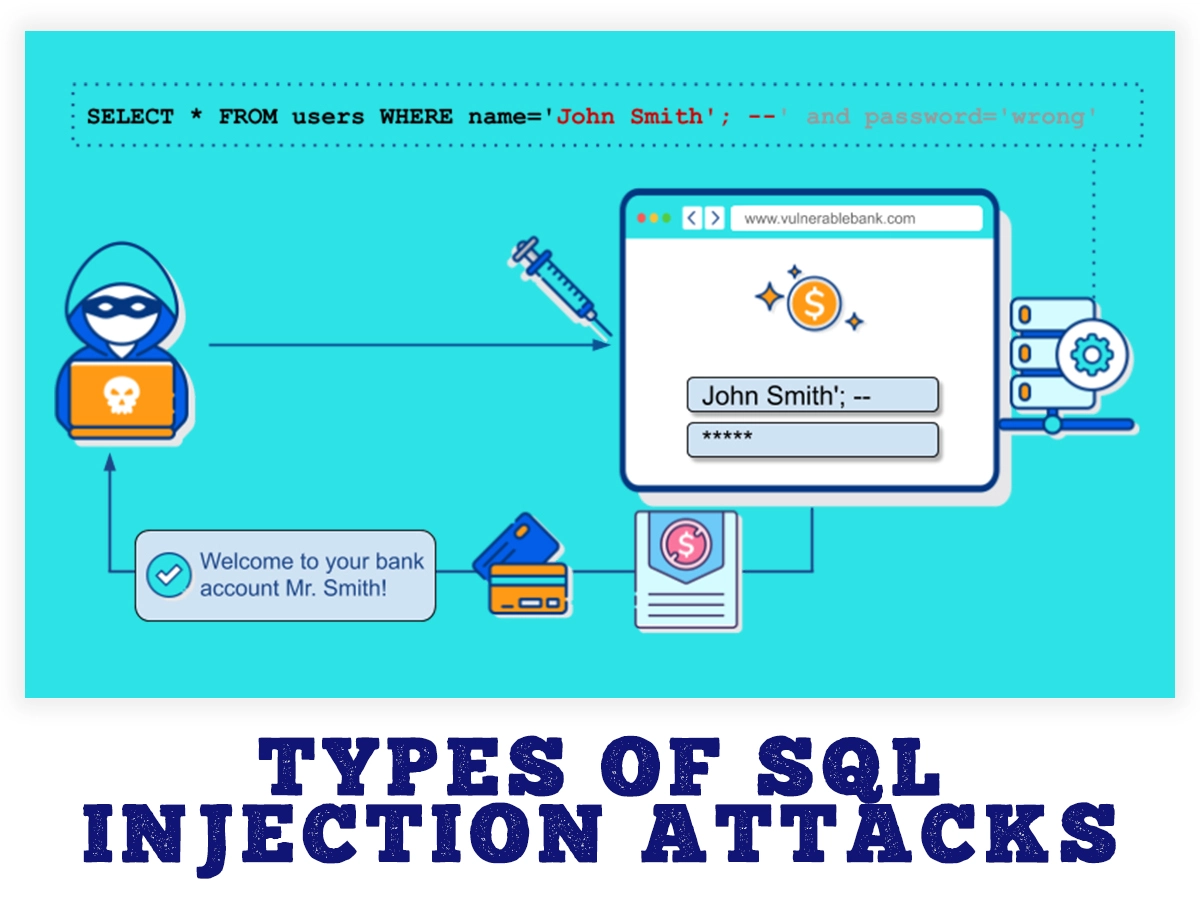SQL, or Structured Query Language, has been considered the standard for handling Relational Database Management Systems (RDBMS) since time immemorial. Now, RDBMS has become common for SQL databases to be connected. But as with every good thing, this too comes with SQL injection attacks on data-driven web apps, also called SQLi attacks, which have been a serious problem.
What is SQL Injection (SQLi)?
In an SQL Injection (SQLi) attack, cybercriminals try to exploit vulnerabilities in your web apps or software’s code by inserting an SQL query into fillable fields, such as usernames or passwords. Attackers will then attempt to pass the SQL statement to the application’s underlying SQL database.
An SQL injection attack happens when attackers implement SQL vulnerabilities by submitting a malicious SQL statement via form fields or regular inputs. Simply put, the attacker will add code to a field to dump or alter data or access the back end.
A malicious SQL statement potentially gives attackers administrator access to a database. This corrupted statement allows them to select data such as employee ID, username, password combinations, or customer records and modify, delete, or data dump anything in their chosen database. Depending on the nature of the SQL database, the right SQL injection attack can allow access to a hosting machine’s OS (operating system) and other network resources,
The success of SQL injection attacks depends on the web-based entry form that allows user-generated SQL statements to query the database directly. These attacks have also proliferated with shared codebases, such as WordPress plugins, which tend to contain a vulnerability in the underlying code pattern. This vulnerability corrupts the entire application and affects tens of thousands of websites that share the same code.
SQL Injection Examples
Manu different kinds of SQL injection vulnerabilities, attacks, and techniques arise in different situations. Some common SQL injection attack examples include:
- Examining the database: The attacker can extract information about the version and structure of the database.
- In blind SQL injection: The attacker can tamper with the results of a query you control that are not returned in the application’s responses.
- Retrieving confidential data: The attacker can modify an SQL query to return additional results.
- Subverting application logic: The attacker can change a query to interfere with the application’s logic.
- UNION attacks: The attacker can retrieve data from different database tables.
For instance, let’s look at an example below that shows how attackers exploit concatenation weakness.
The sample code below results in the current username. And it also searches for items matching a specific item_name, where the current user is the owner.
string user
Name = ctx.getAuthenticatedUserName();
string query = “SELECT * FROM items WHERE owner = “X”
+ userName + “‘ AND itemname = ‘”
+ ItemName.Text + “‘”;
After combing through this data, you’ll get the username and item name along with this query:
SELECT * FROM items
WHERE owner =
AND itemname = ;
The challenge, in this situation, is that the original code uses concatenation to combine data.
As item name, the attacker may use a string such as ‘name’ OR ‘a’=’a.’ The condition ‘a’=’a’ will always hold true; thus, the SQL statement will hold true for every item in the table.
Now the SQL statement reads:
SELECT * FROM items
WHERE owner = ‘Alan’
AND itemname = ‘name’ OR ‘a’=’a’;
In simpler terms, it’s the same as SELECT * FROM items;
Therefore, the above query will return the entire table’s data, giving the attacker unauthorized access to sensitive data.
Types Of SQL Injection Attacks

Unsanitized Input
Unsanitized input is a very common type of SQL Injection attack. And it occurs when cybercriminals provide user input that is not properly sanitized for characters that should escape. Also, in some cases, the input isn’t validated to be the type that is correct or as expected.
For instance, an eCommerce website might request the user’s account number in a web form and send that to the DB to pull up the associated account information. If the app builds a SQL query string dynamically with the account number the user provided, it might look something like this:
SELECT * FROM customer_data WHERE account_number = ‘“ + user_Provided_AccountNumber +”’;
It works like a charm for users who enter their account numbers correctly, but it still leaves an opening for attackers. For instance, if folks decide to provide an account number of “ABCD‘ or ‘1’ = ‘1”, it will look something like this:
“SELECT * FROM customer_data WHERE account_number = ‘ABCD’ or ‘1’ = ‘1’;
The ‘1’ = ‘1’ always evaluates to TRUE. That’s why sending this statement to the database returns data for all customers instead of just a single customer.
Content-based SQL Injection
Content-based SQLi attacks, also known as Boolean SQLi, force any app or software to return different results depending on the malicious SQL query returning a TRUE or FALSE result. Whether the content in the HTTP response stays put or changes depends on the query’s results. As a result, the attacker can choose whether the malicious payload returns a TRUE or FALSE result despite the query returning no data from the database.
Time-based SQL Injection
The time-based SQLi attacker sends a query that forces the web app to wait for a specific duration before returning a response. Cybercriminals commonly use this response time to determine whether the query’s result is TRUE or FALSE.
Blind SQLi
Blind SQLi or Inferential SQL Injection attack doesn’t reveal data directly from the targeted database. Instead, cybercriminals closely examine indirect clues in behavior and details within HTTP responses, how long it takes the database to respond to certain user input, and blank web pages for certain user input. Also, remember that all these things are clues depending on the attacker’s goal; of course, they can also point to another SQLi attack avenue for the attacker to try.
Inferential (Blind) SQLi
In inferential or blind SQLi attacks, cybercriminals query the database & observe the server’s behavior to gather information about the database’s structure. These attacks are slow, but they can be equally harmful as other types of SQLi.
In-band SQLi
The simple and efficient nature of the In-band SQLi has turned it into one of the most common types of SQLi attacks. Cybercriminals use the same communication channel to launch attacks and gather results. This attack also has two sub-variations:
- Union-based SQLi: It takes advantage of the UNION SQL operator. This operator fuses multiple select statements generated by the database to get a single HTTP response, which may contain data the attacker can leverage.
- Error-based SQLi: This attack involves actions that cause the database to produce error messages. Cybercriminals use the data provided by these error messages to gather information about the structure of the database.
Tips To Prevent SQL Injection Attacks

Input validation, parameterized queries, and prepared statements are among the best ways to prevent SQL Injection attacks. You should never input your code directly, and the developer must sanitize all input, not only web form inputs such as login forms. It’s always a good idea to reduce the visibility of database errors on your production sites. Use Database errors with SQL Injection to gain information about your database.
Follow these tips if you’re a company, small business, or upcoming brand and are concerned about SQL injection prevention:
1. Staff Training
Train your staff or the team responsible for your web application and make them aware of SQLi-based risks. And try providing essential role-based training to all users.
2. Always Keep User Input in Check
User inputs used in SQL queries introduce risk, so address input from authenticated or internal users and verify it the same way public input is verified. And award minimum privileges to accounts that connect to the SQL database.
3. Use the Latest Versions
It’s imperative that you always use the latest development environment & language version as it’ll maximize protection and provide you with better security features than older versions. Always ensure that you install the latest software & security patches when available.
4. Don’t Use Dynamic SQL
- Don’t ever place user-provided inputs into SQL statements.
- It would be best if you always preferred prepared statements and parameterized queries as they’re much safer.
- Stored procedures are safer than dynamic SQL, so try using them instead
5. Use a WAF or Web Application Firewall for Web Apps that access databases
- WAF protects web-facing applications and helps identify SQL injection attempts.
- Based on how the WAF is set up, it will help to prevent SQL injection attempts from reaching the app or, more importantly, the database.
Worrying about SQL injection attack – Contact Imagine IT now
Conclusion
SQL injection attacks continue to significantly threaten web applications and databases. They can lead to the theft of sensitive data, manipulation of database content, and even complete system compromise.
There are various types of SQL injection attacks, including error-based, boolean-based, and time-based attacks, and they can affect any website that relies on a SQL database.
However, there are several measures that organizations and individuals can take to prevent SQL injection attacks, such as using parameterized queries, sanitizing user input, and keeping software up to date.
By taking a proactive approach to security and staying informed about the latest threats and best practices, it is possible to protect web applications and databases from the devastating consequences of SQL injection attacks.





